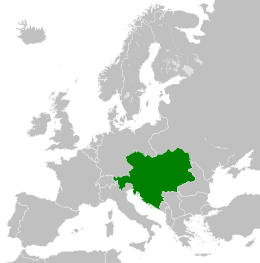More languages
More actions
| Austro-Hungarian Monarchy Österreichisch-Ungarische Monarchie (German) Osztrák–Magyar Monarchia (Hungarian) | |
|---|---|
| 1867–1918 | |
Motto: Indivisibiliter ac inseparabiliter Indivisibly and inseparably | |
Anthem: Gott erhalte Franz den Kaiser | |
 Austro-Hungary in 1914 | |
| Capital | Vienna (Austria) Budapest (Hungary) |
| Largest city | Vienna |
| Official languages | German Hungarian Serbo-Croatian |
| Dominant mode of production | Capitalism |
| Government | Federal parliamentary constitutional monarchy |
| Area | |
• Total | 621,538 km² |
Austria-Hungary, officially the Austro-Hungarian Monarchy, often referred to as the Austro-Hungarian Empire or the Dual Monarchy, was a European state that occupied several Central European nations. It was established in 1867 as a compromise between the declining Habsburg monarchy that was trying to preserve its power and Hungarians who sought greater autonomy. The ruler of the empire ruled as both Emperor of Austria and King of Hungary.[1]
History
Foundation
Following its military defeat in the Austro-Prussian War in 1866 the Austrian Empire was forced to negotiate with the Hungarian aristocracy. This resulted in a settlement in 1867 which turned the Austrian Empire into the Dual Monarchy, allowing the Austrian and Hungarian ruling classes to work together in order to oppress the rest of the empire's nationalities.[2]
Imperialist power
Although weaker than the other European empires Austria-Hungary was still a great power and used its power to oppress weaker nations even with its internal instability. Austria was increasingly forced under the influence of the German Empire, concluding the Austro-German alliance in 1879 and shortly after the Triple alliance with Germany and Italy was concluded in 1882.[2]
By the start of the 20th century Austria-Hungary was conclusively in the monopoly capitalist stage with several monopolistic companies being active across the Dual Monarchy and the Balkans. Austro-Hungarian capitalism unlike other imperialists empires was different in that it retained some feudal elements, was less industrially developed and was reliant on German capital.[3]
Austria-Hungary's expansion was focussed on the Balkans which put it into conflict with the Russian Empire and Serbia. In 1878 it occupied Bosnia from the ailing Ottoman Empire and annexed it in 1908 causing the Bosnian Crisis.[3] Austria-Hungary was also active in preserving European interests in China, albeit to a limited extent, and provided some troops for the imperialists suppression of the 1901 Boxer Rebellion. From this conflict Austria-Hungary gained a small territorial concession in the city of Tianjin which it occupied from 1901 until its 1917 annexation by the Entente in during the First World War.[4]
First World War
On 28 June 1914 Gavrilo Princip assassinated the heir to the Austrian throne, Archduke Franz Ferdinand, during a visit to Sarajevo, Bosnia. Austria-Hungary blamed Serbia for the assassination as the assassin happened to be a Bosnian Serb, taking the opportunity to attack Serbia it had been waiting for. On 23 July the Dual Monarchy sent an absurdly harsh ultimatum to Serbia and unsatisfied with the Serbian response, attacked Serbia on 28 July. This set off a chains of events in which all the great powers declared war on each other, setting fire to the tension between the European empires that had brewing for decades and beginning the First World War.[1]
Fighting on the side of the Central Powers alongside Germany, Austria-Hungary performed poorly in the war losing battles from the outset. In August and September 1914, the Russians routed the Austrian army in the battle of Galicia with a further breakthrough by the Russian army in June-August 1916 leading to further defeats. From 1916 onwards the Dual Monarchy only grew more exhausted with a failing economy and civil unrest rising rapidly, particularly among the oppressed minorities.[3]
In January 1918 the workers declared a general strike and they were soon joined by several other groups across the disintegrating empire. In October-November 1918 the movements culminated in several successful bourgeois revolutions with the bourgeois states of Austria, Hungary and Czechoslovakia being created in the empire's ruins and portions of the collapsed empire's lands being included in Romania, Poland and Yugoslavia.[3] The victorious Entente powers would later confirm the new borders in the 1919 Treaty of St Germain with some of their own changes to further their own imperialist ambitions and stabilise the new bourgeois states to prevent the proletariat from succeeding in a revolution.[5]
Politics

Austria-Hungary was comprised of two parts: Cisleithania, the Austrian section, and Transleithania, the Hungarian section. The two entities governed somewhat independently but shared the three common ministries of finance, foreign affairs, and military-naval.[6]
Demographics
Austria-Hungary contained 12 million Austrians, 10 million Hungarians, 6.6 million Czechs, 5 million Poles, 4 million Ukrainians, 3.2 million Croats, 2.9 million Romanians, 2 million Slovaks, 1.3 million Slovenes, and 700,000 Italians.[1]
References
- ↑ 1.0 1.1 1.2 Neil Faulkner (2013). A Marxist History of the World: From Neanderthals to Neoliberals: 'Imperialism and War' (pp. 182-184). [PDF] Pluto Press. ISBN 9781849648639 [LG]
- ↑ 2.0 2.1 M. A. Poltavskii (1979). The Great Soviet Encyclopedia: 'Austria; The Hapsburg monarchy in the last third of the 19th century'.
- ↑ 3.0 3.1 3.2 3.3 M. A. Poltavskii (1979). The Great Soviet Encyclopedia: 'Austria; 1900–18'.
- ↑ Michael Falser, Georg Lehner (2022). Habsburgs going global. The Austro-Hungarian Concession in Tientsin/Tianjin in China (1901-1917). [PDF] Verlag der Österreichischen Akademie der Wissenschaften. ISBN 978-3-7001-8927-5
- ↑ I. S. Kremer (1979). The Great Soviet Encyclopedia: 'Austria; Austria from 1918 to 1938'.
- ↑ M. A. Poltavskii (1979). The Great Soviet Encyclopedia: 'Austria; The Hapsburg monarchy in the last third of the 19th century'.


